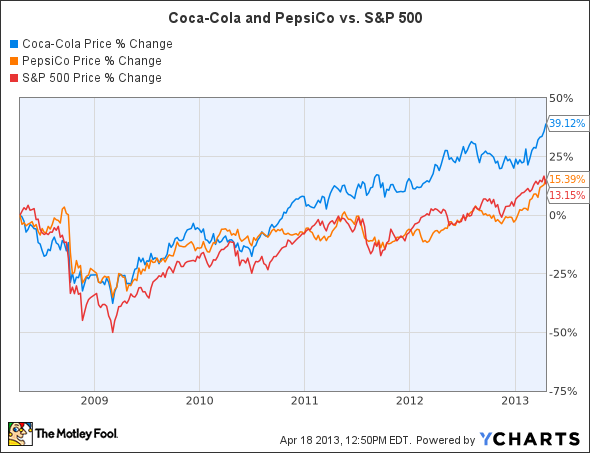These days, as the market is dragged down by falling prices of gold and oil, investors might have overlooked one sparkling black liquid that is bubbling to the brim – cola. Beverage giants The Coca-Cola Company (NYSE:KO) and its rival PepsiCo, Inc. (NYSE:PEP) both recently topped earnings expectations, and shares have rallied substantially even as the rest of the market fell apart. Are these two companies, often regarded as slow, stodgy stocks, the new growth stocks of this decade, due to a strengthening portfolio and international growth?
A sparkling first quarter
For its first quarter, Coca-Cola earned an adjusted $0.45 per share, flat from the prior year quarter but topping analyst expectations by a penny. However, including unfavorable currency impacts, earnings per share actually came in at a GAAP-adjusted $0.39 per share. Meanwhile, revenue declined slightly from $11.14 billion to $11.04 billion, but also came in ahead of the $10.97 billion analysts had expected.
Meanwhile, PepsiCo, Inc. (NYSE:PEP) earned an adjusted $0.77 in the first quarter, up from $0.71 in the prior year quarter and topping the consensus estimate of $0.71. However, including an $0.08 impact from currency devaluation in Venezuela, earnings growth was flat from the previous year. Meanwhile, revenue rose 1% to $12.58 billion, beating the forecast of $12.53 billion.
In other words, both The Coca-Cola Company (NYSE:KO) and PepsiCo posted nearly flat earnings and revenue growth from the prior year, yet shares of both surged to ten-year highs after earnings. What prompted such a bullish response?
In North America, both companies posted poor growth, with Coca-Cola’s revenue declining 1% while PepsiCo’s beverage business dipped 0.6%. However, international sales tell a very different story, and highlight the strengths and weaknesses of both companies in different global regions.
In crisis-stricken Europe, Coca-Cola’s revenue declined 2%, but PepsiCo’s beverage revenue rose 4%. In the Pacific-Asia region, Coca-Cola’s revenue dropped 4%, due to an unfavorable product mix and foreign exchange rates. PepsiCo, Inc. (NYSE:PEP) apparently fared worse in Asia, with a 14% plunge, but after excluding the impact of re-franchising bottling operations in China, revenue actually rose 15%.
Lastly, in the Eurasia region (which includes the Middle East and Africa), The Coca-Cola Company (NYSE:KO)posted 9% revenue growth due to growth in volume, concentrate sales and better pricing power. Excluding currency impacts, sales rose 13%.
In other words, global sales were a mixed bag. In terms of total volume growth, Coca Cola (NYSE:KO)’s international markets grew by 5%, while volume in North America only rose 3%. By comparison, PepsiCo’s international beverage volume rose 6%, but fell 3% in North America.
It’s not all about soda anymore
When comparing Coca-Cola to PepsiCo, however, it’s important to remember that the two companies’ operations are vastly different. While Coca-Cola is fully dedicated to selling carbonated and non-carbonated drinks, PepsiCo’s business is split into beverages and snack foods under its Frito-Lay subsidiary.

Meanwhile, PepsiCo, Inc. (NYSE:PEP)’s beverage portfolio is notably weaker than Coca-Cola’s, so it has relied on its Frito-Lay snack business, which produces Lays, Ruffles, Doritos, Tostitos and Cheetos, to offset some losses in its beverage business. Frito-Lay didn’t disappoint during the first quarter, growing its revenue 4% to $3.12 billion, while operating profit jumped 6% to $828 million. Combined with PepsiCo’s Quaker Oats brand, the company’s Americas food segment reported 5.3% growth in revenue to $5.12 billion, driven by strong demand in the United States and Latin America.
99 bottles of Coke on the wall…
Over the past three years, both Coca-Cola and PepsiCo have faced steep challenges from rising commodity and raw material costs, regardless of their focus on beverages or packaged foods. However, recent declines in oil and corn costs should have a positive impact on margins, especially by reducing the cost of high-fructose corn syrup, a major ingredient of sodas and processed foods. As we can see in the chart below, The Coca-Cola Company (NYSE:KO) still has the edge in margins.



